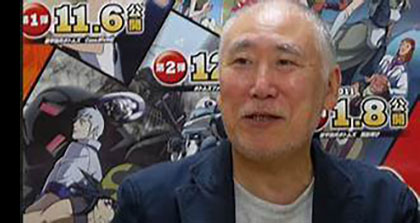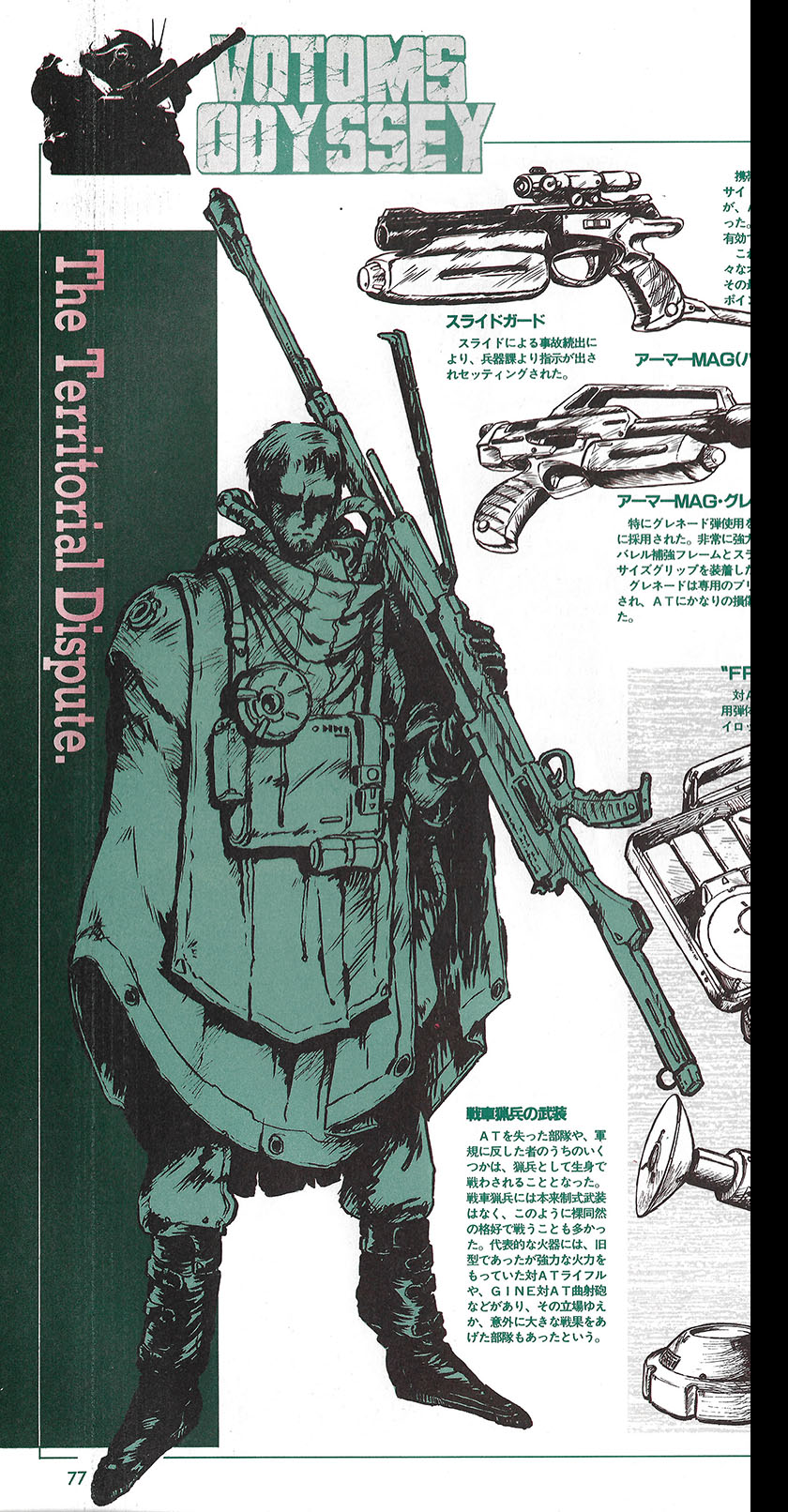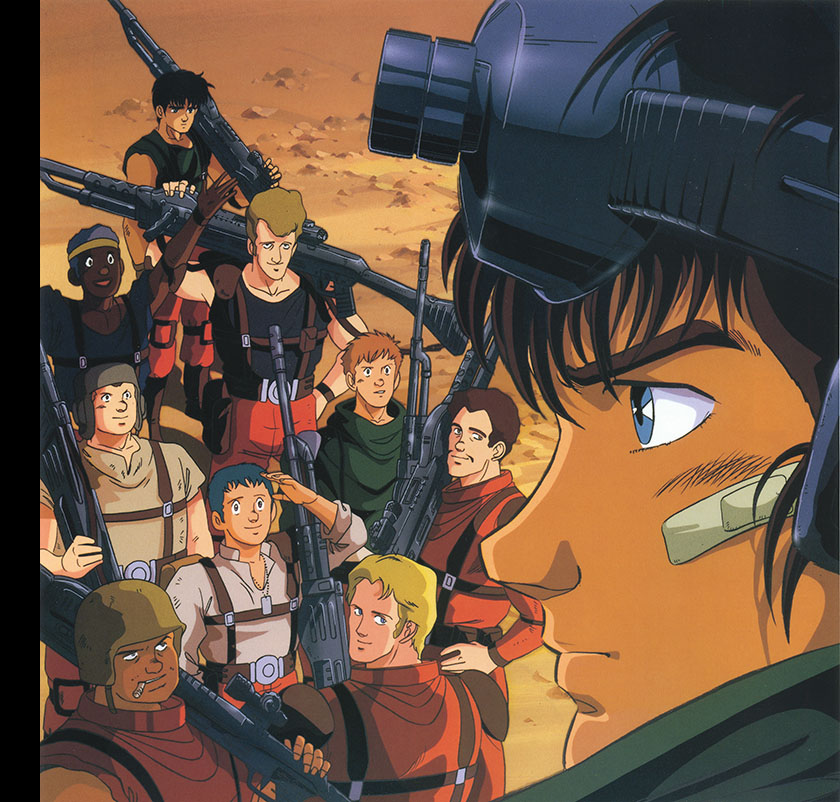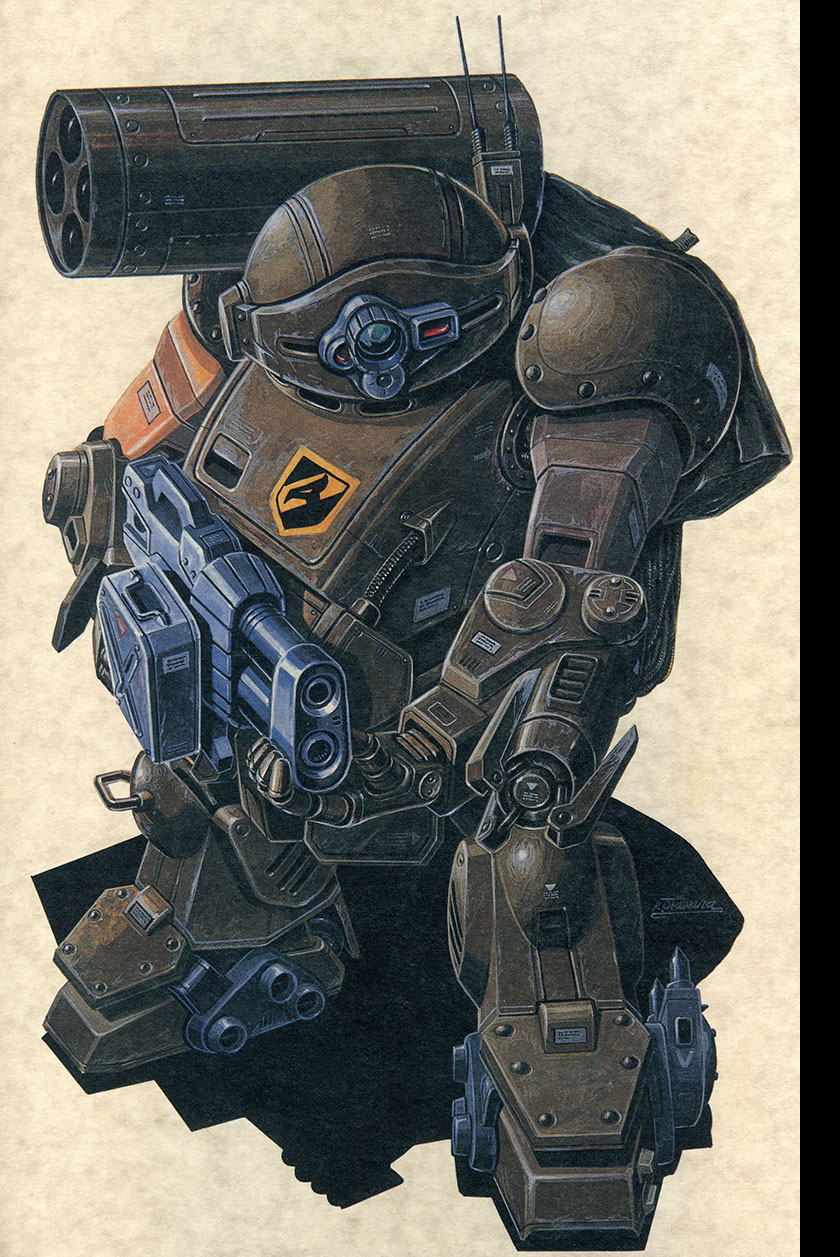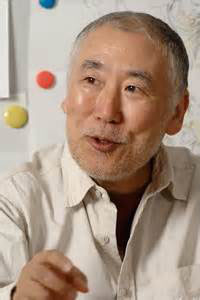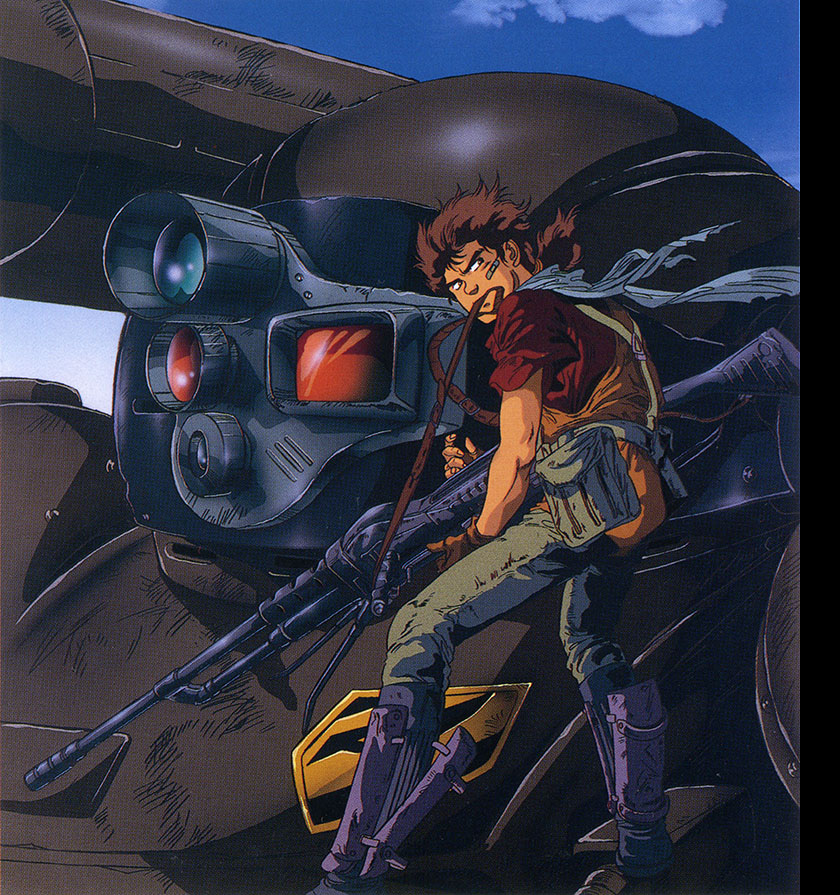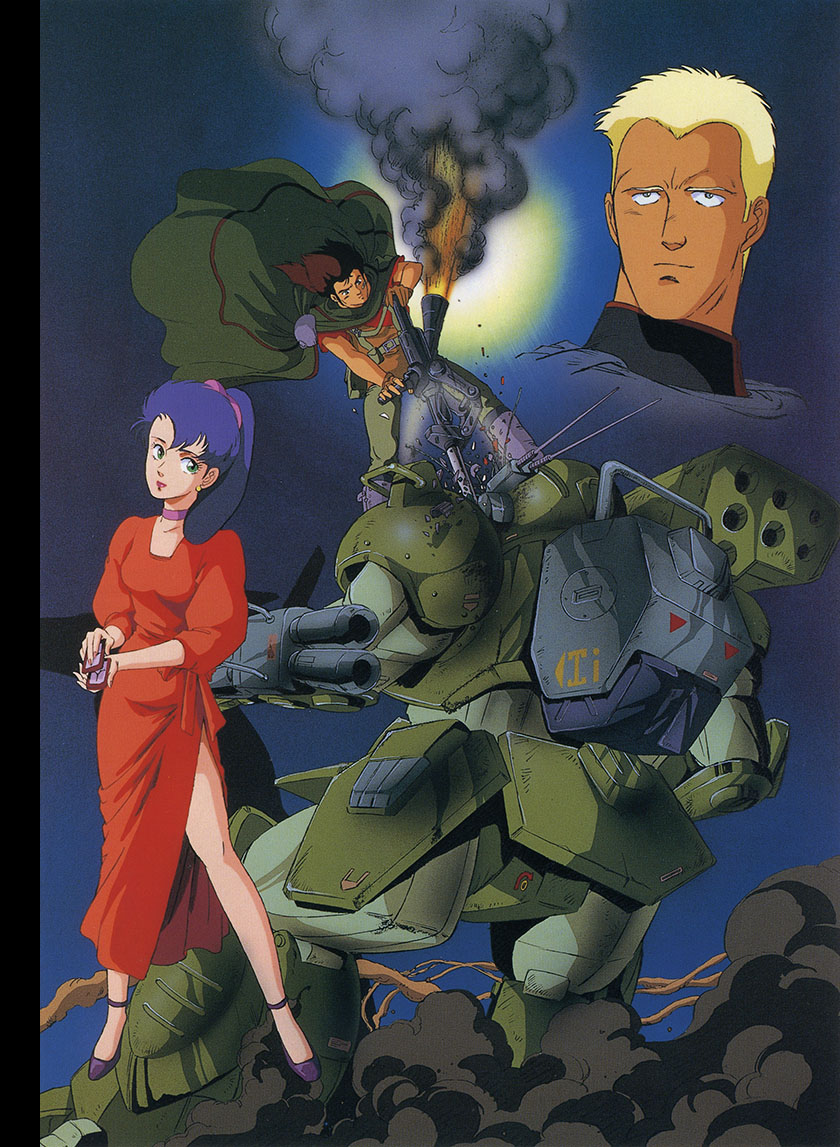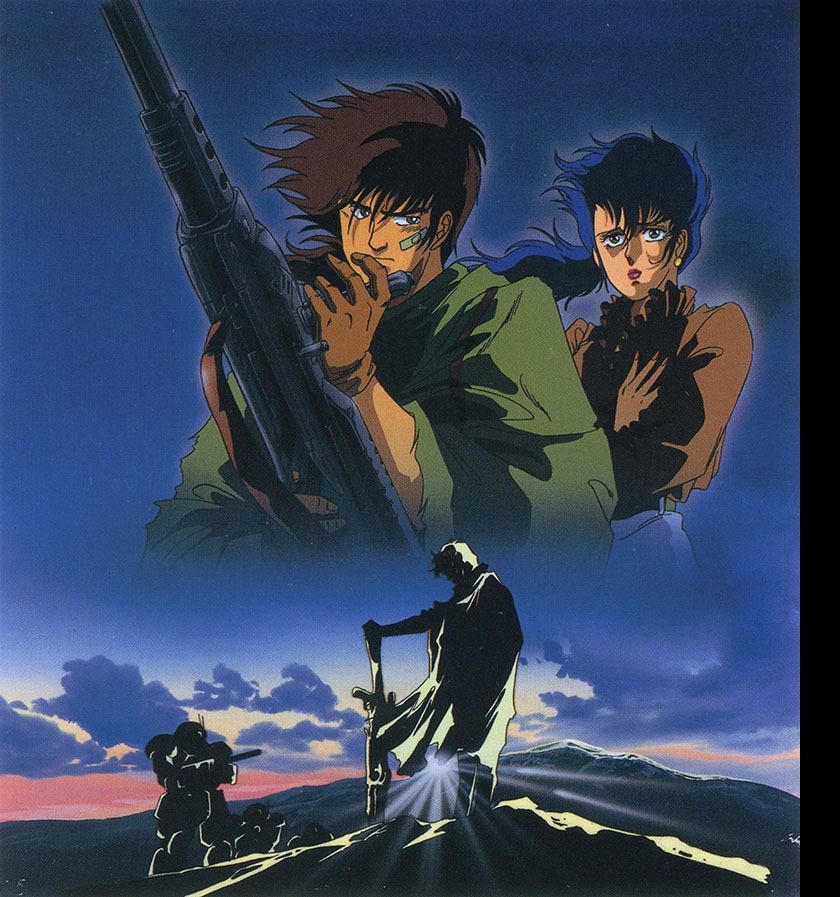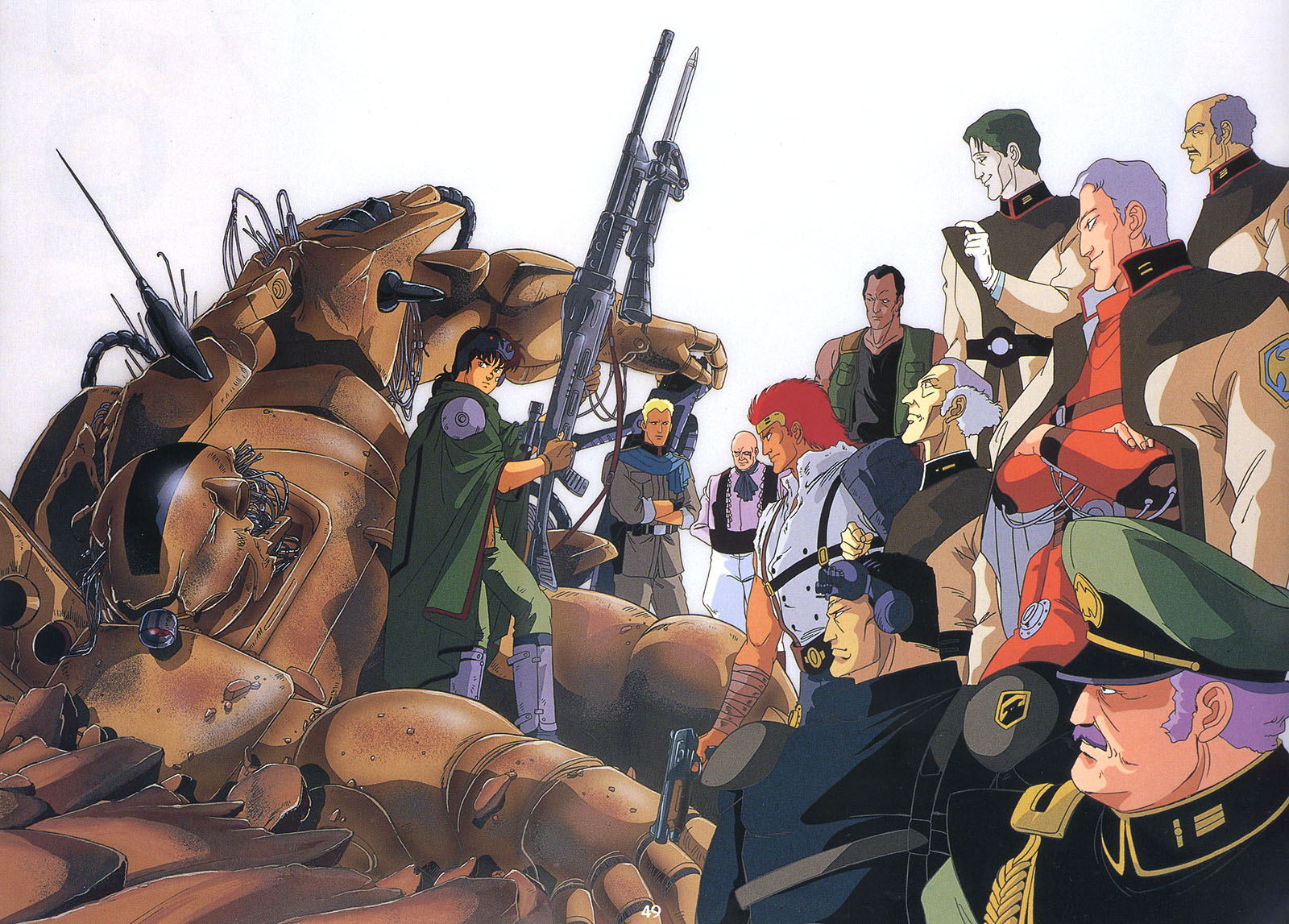Armor Hunter Merowlink
Ryosuke Takahashi interviews
By the time Armored Trooper Votoms finished its first broadcast in Spring 1984, the momentum already existed to expand it beyond its initial framework. The setting was a huge, sprawling galaxy with any number of stories to be told. The first animated spinoff appeared in 1985 to take full advantage of the OVA boom, and even as Chirico Cuvie’s story seemingly played itself out with Roots of Ambition in 1988, a successor was ready to take the stage.
His name was Ality Merowlink, and his immersive 12-episode story was released in six volumes from November 1988 through April 1989. It struck the perfect creative balance, building on the world we already new and blazing its own trail to make that world bigger. At once a hardcore anime mecha story and a stylish revenge drama, it doesn’t lose an ounce of freshness even when you watch it decades later.
This is mainly due to the steady hand of writer/creator Ryosuke Takahashi, who displayed his other greatest talent on this project: hiring the right people. Below are two interviews with him recorded twelve years apart. Be sure to also read the staff interview collection; like the people themselves, the interviews work together to deliver a complete picture.
1994 Interview
Published in the Armor Hunter Merowlink LD box set (released by VAP in 1994)
Interviewer: I would like to ask you how the story of Merowlink was created.
Takahashi: At the start, we were going to do a robot thing for video. We had already done robot/robot fights in various places, so we decided to do a human/robot fight. In that case, the main character couldn’t pilot a robot to defeat a human. (Laughs) So I tried to come up with the opposite pattern.
In those days, the robot was a sponsor’s product. I thought it would be impossible to do a work for TV without a protagonist piloting the product. It wasn’t just me, the producers also came to that conclusion. Also, there was a request to make a Votoms spinoff. I wanted to do this story (a battle between robot and human) set in that world.
A “hunter” appeared in Votoms Odyssey (a 1985 book published by Minori Shobo) and I’d been interested in this for a long time, so I came up with a story about an armored hunter who defeats an AT. Robots could always fight other robots, but for a human to do it, there must be some kind of grudge there. That’s how I came up with the story of Merowlink and the Schwepps Platoon and the revenge drama.
Interviewer: Tell us about the character of Merowlink.
Takahashi: Chirico, the main character in Votoms, is about 18 years old. My impression was that this was a little too old. For Merowlink, I wanted the protagonist to be an age that middle and high school students relate to. I decided to make him a 17-year-old boy soldier named Ality Merowlink.
Also, it seemed that both Dougram and Votoms had few female fans. Maybe it wasn’t true, but that’s the impression I got. (Laughs) So I was more conscious of female fans, and I wanted to create a character that wasn’t particularly strong, but would stimulate women’s protective instincts. I also gave him a sweet name, Merowlink. (Laughs)
Interviewer: So you changed the subject matter somewhat from Votoms?
Takahashi: Yes, I did. It’s not that I reduced the drama, but I lowered the age of the main character with whom we can empathize.
Design description: Armed Tank Hunters
Some of the troops who lost their ATs and some of those who defied military discipline were forced to fight as hunters in the flesh. Tank hunters were not originally armed, and often fought naked in this way. Typical firearms included the old but powerful anti-AT rifle, the GINE which had strong firepower. Perhaps because of their position, some units were able to achieve surprisingly large results in battle.
Interviewer: There were many Votoms references, such as the presence of Lieutenant General Battentain.
Takahashi: That’s because we’re in the same world. Someone else would have done it differently, so I thought it would be better to do it myself. I thought it would be fun to have the original Votoms involved in some way. I think there are pros and cons to that kind of thing, but what do you think?
Interviewer: I think it was probably a good thing for Votoms fans. I heard that the novel version with Gotho and Lu Shako was very well received by the fans…
Takahashi: The novel version had more of that element. Because Mr. Kanda was the director, I didn’t want to impose too much of the world of Votoms on him, so I didn’t go that far in the anime. I wanted him to make Merowlink in his own world.
Interviewer: How did you and director Kanda divide the work?
Takahashi: Simply put, I created the story and Kanda-san did the directing. It’s a revenge story, but I lowered the age of the main character. Kanda-san has a softer, warmer way of dealing with characters than I do. So in this case, I thought he would bring a better flavor to the story than I would.
Interviewer: I heard that you appointed [Character Designer/Animator] Moriyasu Taniguchi.
Takahashi: Yes, I did. I had wanted to work with Taniguchi-san for a long time, and we did Layzner, but it ended in the middle of the project. So I wanted to work with him again. I thought that in the world of Merowlink, we could make the most of Taniguchi’s strengths. In fact, he participated in Votoms and the nuance of his art certainly brought more depth to that world. I think it’s a good match for him.
Interviewer: I have questions from fans regarding each character. May I ask?
Takahashi: Yes, go ahead. (Laughs)
Interviewer: Okay, first I have a question about Merow. Why did he grow his his hair long?
Takahashi: I was conscious of fashion of the time. Also, relatively speaking, he looks milder with longer hair. And it’s easier to express emotions with long hair.
Interviewer: The last scene in Episode 8 where the hair is untied was impressive.
Takahashi: Yes, it was. In short, I tried to expand the expression of drawing with his hair.
Interviewer: What about the bandage on his cheek?
Takahashi: That was Mr. Taniguchi’s idea. It’s like a scar on an otherwise healthy boy, or an image of a man playing intense sports.
Interviewer: What happened to Merow’s family?
Takahashi: I intentionally left that part of the story out. I don’t think there are many of them, but I don’t think they’re all dead like Chirico’s. You can be sure that the father is dead, but the mother is alive. But Merow has not been able to identify them. I think they they’re unaware. This doesn’t mean they’re alive and he has a home to go back to.
Interviewer: Is there a set age for the sub-characters in each episode?
Takahashi: I thought about it, but I don’t have a definite age in mind.
Interviewer: Do you have a specific age or family for Boyle?
Takahashi: He would be around 40 years old, maybe in his late 30s. Of course, he has a family. I think he has a wife and children.
Interviewer: Will Merow start a vendetta against Battentain?
Takahashi: The scale of the story doesn’t go that far. Merow doesn’t trust the relationships or the military structure that he thought he had. He trusted them at first, but when he and his friends were betrayed, he stood up for revenge. But taking vengeance didn’t necessarily shake the military structure itself. You can chase the object of your revenge, but when you run up against some sort of structural ambition, you can’t really make that an object of hatred.
The conclusion of the 12 episodes of Merowlink was the culmination of despair for all the institutions he has lived under. In the last episode, he was caught up in a tremendous sense of hopelessness and helplessness. I think he will eventually break out of it. I think his temperament as a man will eventually find an enemy and act on it. If there’s a story beyond this one, I think he’d run into a new enemy and eventually he might end up facing Battentain. But at this point, he’s just overcome with a sense of hopelessness.
Interviewer: And the most frequently asked question…what happened to the second volume of the novelization of Merowlink?
Takahashi: I didn’t have the ability to write novels back then. Not that I do now (laughs), but at that time I was not mature enough to write a novel. After writing one, my sword got dull and I got frustrated. But recently, I’ve started to get back into that area. If the publishers let me, I would probably write again.
Interviewer: I understand. (Laughs) Finally, what would you like people to pay attention to when they see Merowlink again?
Takahashi: When I create a piece, regardless of who directed it or who wrote the script, I’m very conscious of whether a certain spirit is put into an ordinary shot. In the case of Roots of Ambition, Chirico is shot and dies instantly. But later, we said that the bullet was just slightly deflected. In other words, it was simply contrived. (Laughs) But when you watch it, you’re satisfied with it. I think that is the life of directing.
For Merowlink, I was not the director, but the author. I created it as an original story, not based on a manga or novel. I composed the story, created the plot, and wrote some of the scripts. I wanted to work in such a way that if someone else directed it, I would be interested to see if my own colors would come out without me directing.
As for myself, out of the several projects I’ve done at Sunrise, this one definitely has the feel of my involvement. Is that about right?
2006 Interview
Published in the Armor Hunter Merowlink DVD box set (released by VAP in 2006)
Ryosuke Takahashi
Creator, Series Composition
After working at Mushi Pro, Takahashi directed Zerotester for Soeisha, the predecessor of Sunrise. Since then, he has directed Dougram, Votoms, Galient, and SPT Layzner, among others. He is also active in various genres as a directorial collaborator, scriptwriter, and producer.
See his credits at Anime News Network here.
Interviewer: How did the Merowlink project start?
Takahashi: At the time, Sunrise had a new production department, and I was asked to work on a new project for them. Takeyuki Kanda’s schedule was open, and I wanted to do something that would fit his style. He and I have been friends for a long time, and we also worked on Dougram together. Obviously, we’re different creators, but we share similarities. So we came up with the idea of Merowlink, which uses the Votoms world but in a slightly different tone.
Interviewer: I heard that the “tank hunter” in Votoms Odyssey (a 1985 mook published by Minori Shobo) became the prototype for the Armor Hunter.
Takahashi: Yes, I was intrigued by the hunter in the illustrated commentary from the first time I saw it. When I came up with the name Votoms, the image I had in mind was someone at the bottom of the barrel, or a “lousy bastard.” I felt that being a hunter was even lower than that.
If they’re lower than the ordinary ranks in the army, and if they’re trapped, then I thought, “I can make a story with that as the main character.” If it’s beneath the normal system, it may have some punitive meaning. If they were intentionally betrayed, I thought we could turn it into a revenge drama. I like it dramatically.
It’s one of the staples of Japanese drama, not only for me. So for this project, I first thought up the pre-story before the Armor Hunter was dropped into it. Then, with that as a premise, I thought of a story in which the protagonist continues to seek revenge while unraveling the conspiracy behind the plot.
Interviewer: Were there any differences from Votoms due to Mr. Kanda’s directing?
Takahashi: I created the setting and story composition of Merowlink, and it’s my world. But the visuals were under his direction, so it definitely has a different atmosphere from Votoms.
Interviewer: I heard that Kanda-san took Lulucy in a direction he wanted to depict…
Takahashi: That character portrayal is very Kanda-like. The direction I had in mind for Lulucy was not the image of a woman he wanted to portray. Actually, at first, I didn’t have Lulucy in mind as a character who would be involved with Merow. I intended her to interact with Kiek. Lulucy is a little older than Merow. I didn’t intend for them to be lovers at all.
Interviewer: That’s why Kiek and Lulucy appear together in the first episode.
Takahashi: Yes. At every level, Kiek is a better fit than Merow. (Laughs) But it didn’t turn out that way. I like to watch love stories as a viewer, but I’m not good at making them. (Laughs)
Interviewer: Have you worked with Director Kanda for a long time?
Takahashi: I don’t really remember when we started working together. We were friends from the time of Mushi Pro. When he was working on The Adventures of the Little Prince at Knack Studio, he asked me to write scripts for him. After that, when he started working for Sunrise, I didn’t do much Sunrise work. I did show up at his studio and go out drinking with him, though. We had a good relationship.
Interviewer: After that, you co-directed Dougram.
Takahashi: That was at my suggestion. I had been away from TV anime for a long time, and I had no experience with robots. So when we decided to do Dougram, the only condition I gave to Sunrise was that I wanted Kanda-san to help me. He had done a lot, so I learned how to direct robot things while he was on Dougram.
After Gundam, Sunrise’s robots were treated as weapons. This meant there was war in the background. Kanda-san watches a lot of WWII movies. That’s why he was so good at portraying the military and soldiers, and creating details that show the everyday life of the battlefield.
Interviewer: Dougram very carefully depicted the everyday life of the battlefield. There were many motifs in common with Merowlink, such as the military prison and the railroad crossing.
Takahashi: Those parts were mostly Kanda-san’s strength. Dougram was long (75 episodes), so we could afford to do that. Later, there was Deep Blue Fleet, which I was asked to direct at first. But that was a World War II film, so I thought Kanda-san would be a better choice than me, and I recommended him. I decided to write the script.
Interviewer: You also wrote some scripts for Kanda’s Metal Armor Dragonar, didn’t you?
Takahashi: Deep Blue came first, but Dragonar was Kanda-san’s project, so I was asked to write some scripts. But now that I think about it, I guess I wanted a drinking buddy at work. (Laughs) When you have a lot of young staff members around, you also want people of your own generation.
Interviewer: What was your goal in using Moriyasu Taniguchi for character design?
Takahashi: Taniguchi-san is from the same generation as me. I was the one who suggested the idea of using him for Layzner. At the time, he was already a veteran in terms of age. It was the time when he was at his peak as an animator.
However, since he lived in Osaka, I had the impression that he didn’t have many opportunities to become a core staff member. He had energy, but no place to pour it. So I decided to use that energy. (Laughs) However, Layzner ended earlier than originally planned. He still had things he wanted to do, and lot of energy left over. I guess you could say that this feeling led to Merowlink.
Interviewer: His art was also impressive in the Votoms TV series.
Takahashi: Taniguchi-san is an animator, isn’t he? So his animated drawings are more appealing than static ones. Among the animators in that generation, I thought his work was outstanding. In terms of sharing the same view of the world, Norio Shioyama is one of the greatest animators I’ve ever met. I haven’t met anyone who can surpass him. But Taniguchi-san also has a great presence in terms of expressing the world through animation.
I was also attracted to the shadow-like quality of his art. There is a yin and yang to everything, and a character comes to life when both are present. Chirico has an honesty and straightforwardness, and he has his own way of life even though he was born in war. These parts of Chirico are unique to Shioyama. On the other hand, there are parts that have scars and shadows from the war. Mr. Taniguchi added that color to Chirico. Merowlink is a revenge drama, and I thought those parts would come to life even more.
Interviewer: Akio Otsuka played the role of Kiek so well it was hard to believe that it was his debut work.
Takahashi: Yes, he’s a good actor. But the first thing I learned about him was that he’s the son of [actor] Shuo Otsuka. I’m a big fan of Shuo Otsuka, so it was a personal privilege for me to have him in my films. (Laughs) Akio’s Kiek is so comfortable that it’s hard to believe it was his debut. It was complete right from the beginning.
Interviewer: Many of the actors in Merowlink are mainly stage performers, aren’t they?
Takahashi: That’s right. I don’t really have any definite rules about how to act in anime. I think it’s better to change it in various ways depending on the work. However, in my works, I often remove the “symbols” that are a major weapon in anime. That’s why I don’t demand symbolic performances from my actors. In some cases, I eliminate them. I think some people find it difficult to do. Sound Director Yasuo Urakami of APU did the casting. He considers my direction and chooses people that will fit. I’ve never asked for only voice actors to be hired.
Interviewer: While Director Kanda and Mr. Taniguchi created the visual world of Merowlink, Hiroki Inui’s music made it feel that it came from the same world as Votoms.
Takahashi: I have worked with many musicians, but Inui-san is the one who has been with me the most, though he and I don’t have a personal relationship. However, about six months before he passed away, he and his wife visited Mr. Shioyama’s silkscreen art exhibition. Until then, he had never been to any of our events. It seems his wife had been a fan of Votoms for a long time.
When they were riding the JR train together, they saw an ad for the event hanging in the train. They were in the neighborhood, so they decided to drop by. (Laughs) I talked with Mr. Shioyama about it, and we asked Inui-san to come up on stage for the event. I had my digital camera with me at the time and took pictures of the two of us. I tried to send the photos to Mr. Inui, but I heard that he doesn’t use e-mail or a computer at all. (Laughs) So I printed them out and sent them in a sealed envelope. I’m usually too lazy to take pictures or send them. Looking back on it now, it was the last chance I had before he passed away. I feel a sense of karma.
Interviewer: And now Merowlink has been released in a DVD box set. How do you like it?
Takahashi: I looked it over a little before this interview, and I think it’s very well done. (Laughs) I got the impression that it was made in a very hectic situation. I looked back at it thinking, “I’d hate it if it looked messy when I see it now…” But that was not the case at all.
It had been quite a while since I’d last seen it, but I was relieved. I was impressed by the flares in the opening sequence. I wondered why we didn’t show that in Votoms. Now that I think about it, flares are a very atmospheric prop. I guess it didn’t come to mind. I don’t know much about the military. (Laughs)
Interviewer: And yet, people say that Director Ryosuke Takahashi is good at military films.
Takahashi: That’s what they seem to think. Actually, it’s not true at all. (Laughs) So, after Kanda-san passed away, I’m having a hard time finding someone who is strong in that area. Even if I do, most of them are strong only in recent military affairs. It’s hard to find someone who can bring out the scent of the WWII era, which I like.
(Recorded October 26, 2006 at Sunrise headquarters)

